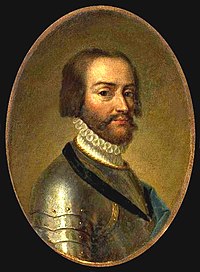Charles, Duke of Vendôme
| Charles | |||||
|---|---|---|---|---|---|
| Duke of Vendôme | |||||
 18th-century portrait | |||||
| Born | 2 June 1489 Château de Vendôme, France | ||||
| Died | 25 March 1537 (aged 47) Amiens, France | ||||
| Spouse | Françoise d'Alençon | ||||
| Issue | Antoine, King of Navarre Francis, Count of Enghien Charles, Archbishop of Rouen John, Count of Soissons Louis, Prince of Condé | ||||
| |||||
| House | Bourbon | ||||
| Father | Francis, Count of Vendôme | ||||
| Mother | Marie de Luxembourg | ||||
Charles de Bourbon (2 June 1489 – 25 March 1537) was a French prince du sang and military commander at the court of Francis I of France. He is notable as the paternal grandfather of King Henry IV of France.
Biography
Charles was born at the Château de Vendôme, eldest son of Francis de Bourbon, Count of Vendôme and Marie of Luxembourg.[1][2]
Charles succeeded his father as Count of Vendôme in 1495. Charles's first military service was in Italy, under King Louis XII of France. In 1514, he was created Duke of Vendôme when the county of Vendôme was elevated into a duchy.[3] He fought at the Battle of Marignano (1515) and participated in the Flemish campaign. Because of his loyalty to the King, he was appointed head of the council when King Francis I was captured at the Battle of Pavia.[4]
On 18 May 1513, Charles married Françoise d'Alençon, eldest daughter of René, Duke of Alençon and Margaret of Lorraine.[5] They had thirteen children:
- Louis de Bourbon (1514–1516), died in infancy.
- Marie de Bourbon (1515–1538), unmarried, prospective bride of King James V of Scotland in 1536.
- Marguerite de Bourbon (1516–1589), married in 1538, Francis I, Duke of Nevers (1516–1561).
- Antoine de Bourbon, Duke of Vendôme (1518–1562)[2]
- François de Bourbon, Count of Enghien (1519–1546), unmarried.
- Madeleine de Bourbon (1521–1561), Abbess of Sainte-Croix de Poitiers.
- Louis de Bourbon (1522–1525), died in infancy.
- Charles de Bourbon (1523–1590), Archbishop of Rouen.
- Catherine de Bourbon (1525–1594), Abbess of Soissons.
- Renée de Bourbon (1527–1583), Abbess of Chelles.
- Jean de Bourbon, Count of Soissons and Enghien (1528–1557), married in 1557, his first cousin, Marie, Duchess of Estouteville (1539–1601).
- Louis I de Bourbon, Prince of Condé (1530–1569), married Eléonore de Roye, daughter of Charles de Roye, Count of Royce.
- Léonore de Bourbon (1532–1611), Abbess of Fontevraud.
The successive deaths of his cousins Charles IV, Duke of Alençon (1525) and Charles III, Duke of Bourbon (1527) made him the fourth in the order of succession to the throne, just behind the king's sons. At the natural course of affairs his wife, a sister of the last duke of Alençon, would have been the heiress of her brother; but Francis I allowed his sister, Marguerite of Angoulême, the late duke's wife, to keep them, even though they did not have children. Charles would also have been heir to the duchy of Bourbon, but it was forfeited to the crown by the treason of the last holder. At the death of Constable de Bourbon in 1527, he became the Head of the House of Bourbon.
His son Antoine married Jeanne d'Albret, Queen of Navarre, daughter of Marguerite of Angoulême, settling the Alençon inheritance. Their son would succeed to the French throne as Henry IV. Antoine and Louis, Prince of Condé, became powerful military leaders on opposite sides in the French Wars of Religion. Charles died at Amiens in 1537 at the age of 47.
Ancestors
| Ancestors of Charles, Duke of Vendôme | ||||||||||||||||||||||||||||||||||||||||||||||||||||||||||||||||||||||||||||||||||||||||||||||||||||||||||||||||||||||||||||||||||||||||||||||||||||||||||||||||||||||||||||||||||||||||||||||||||||||||||||||||||||||||||||||||||||||||||||||||||||||||||||||||||||||||||||||||||||||||||||||||||||||||||||||||||||||||||||||||||||||||||||||||||||||||||||||||||||||||||||||||||||||||||||||||||||||||||||||||||||||||||||||||||||||||||||||||||||||||||||||||||||||||||||||||||||||||||||||||||||||||||||||||||||||||||||||||||||||||||||||||||||||||||||||||||||||||||||||||||||||||||||||||||||||||||||||||
|---|---|---|---|---|---|---|---|---|---|---|---|---|---|---|---|---|---|---|---|---|---|---|---|---|---|---|---|---|---|---|---|---|---|---|---|---|---|---|---|---|---|---|---|---|---|---|---|---|---|---|---|---|---|---|---|---|---|---|---|---|---|---|---|---|---|---|---|---|---|---|---|---|---|---|---|---|---|---|---|---|---|---|---|---|---|---|---|---|---|---|---|---|---|---|---|---|---|---|---|---|---|---|---|---|---|---|---|---|---|---|---|---|---|---|---|---|---|---|---|---|---|---|---|---|---|---|---|---|---|---|---|---|---|---|---|---|---|---|---|---|---|---|---|---|---|---|---|---|---|---|---|---|---|---|---|---|---|---|---|---|---|---|---|---|---|---|---|---|---|---|---|---|---|---|---|---|---|---|---|---|---|---|---|---|---|---|---|---|---|---|---|---|---|---|---|---|---|---|---|---|---|---|---|---|---|---|---|---|---|---|---|---|---|---|---|---|---|---|---|---|---|---|---|---|---|---|---|---|---|---|---|---|---|---|---|---|---|---|---|---|---|---|---|---|---|---|---|---|---|---|---|---|---|---|---|---|---|---|---|---|---|---|---|---|---|---|---|---|---|---|---|---|---|---|---|---|---|---|---|---|---|---|---|---|---|---|---|---|---|---|---|---|---|---|---|---|---|---|---|---|---|---|---|---|---|---|---|---|---|---|---|---|---|---|---|---|---|---|---|---|---|---|---|---|---|---|---|---|---|---|---|---|---|---|---|---|---|---|---|---|---|---|---|---|---|---|---|---|---|---|---|---|---|---|---|---|---|---|---|---|---|---|---|---|---|---|---|---|---|---|---|---|---|---|---|---|---|---|---|---|---|---|---|---|---|---|---|---|---|---|---|---|---|---|---|---|---|---|---|---|---|---|---|---|---|---|---|---|---|---|---|---|---|---|---|---|---|---|---|---|---|---|---|---|---|---|---|---|---|---|---|---|---|---|---|---|---|---|---|---|---|---|---|---|---|---|---|---|---|---|---|---|---|---|---|---|---|---|---|---|---|---|---|---|---|---|---|---|---|---|---|---|---|---|---|---|---|---|---|---|---|---|---|---|---|---|---|---|---|---|---|---|---|---|---|---|---|---|---|---|---|---|---|---|---|---|---|---|---|---|---|---|---|---|---|---|---|---|---|---|---|---|---|---|---|---|---|---|---|---|---|---|---|---|---|---|---|---|---|---|---|---|---|---|---|---|---|---|---|---|---|---|---|---|---|---|---|---|---|---|---|---|---|---|---|---|---|---|---|---|---|---|---|---|---|---|---|---|---|---|---|---|---|---|---|---|---|---|---|---|---|---|
| ||||||||||||||||||||||||||||||||||||||||||||||||||||||||||||||||||||||||||||||||||||||||||||||||||||||||||||||||||||||||||||||||||||||||||||||||||||||||||||||||||||||||||||||||||||||||||||||||||||||||||||||||||||||||||||||||||||||||||||||||||||||||||||||||||||||||||||||||||||||||||||||||||||||||||||||||||||||||||||||||||||||||||||||||||||||||||||||||||||||||||||||||||||||||||||||||||||||||||||||||||||||||||||||||||||||||||||||||||||||||||||||||||||||||||||||||||||||||||||||||||||||||||||||||||||||||||||||||||||||||||||||||||||||||||||||||||||||||||||||||||||||||||||||||||||||||||||||||
Patrilineal descent
| Patrilineal descent |
|---|
|
Charles' patriline is the line from which he is descended father to son. Patrilineal descent is the principle behind membership in royal houses, as it can be traced back through the generations - which means that if Duke Charles were to choose an historically accurate house name it would be Robertian, as all his male-line ancestors have been of that house. Charles is a member of the House of Bourbon, a branch of the Capetian dynasty and of the Robertians. Charles' patriline is the line from which he is descended father to son. It follows the Kings of France and the Counts of Paris and Worms. This line can be traced back more than 1,200 years from Robert of Hesbaye to the present day, through Kings of France & Navarre, Spain and Two-Sicilies, Dukes of Parma and Grand-Dukes of Luxembourg, Princes of Orléans and Emperors of Brazil. It is one of the oldest in Europe.
|
References
- ^ Potter 1993, p. 73.
- ^ a b Busby et al. 1993, p. 145.
- ^ Knecht 1982, p. 15-16.
- ^ Knecht 1982, p. 179.
- ^ Potter 1995, p. 111.
Sources
- Busby, Keith; Freeman, M.J.; Houppermans, Sjef; Pelckmans, Paul, eds. (1993). Les Manuscrits de Chrétien de Troyes. Vol. Volume 2. Rodopi.
{{cite book}}:|volume=has extra text (help); Invalid|ref=harv(help) - Knecht, R.J. (1982). Francis I. Cambridge University Press.
{{cite book}}: Invalid|ref=harv(help) - Potter, David (1993). War and Government in the French Provinces, Picardy 1470-1560. Cambridge University Press.
{{cite book}}: Invalid|ref=harv(help) - Potter, David (1995). A History of France, 1460-1560. St. Martin's Press.
{{cite book}}: Invalid|ref=harv(help)

